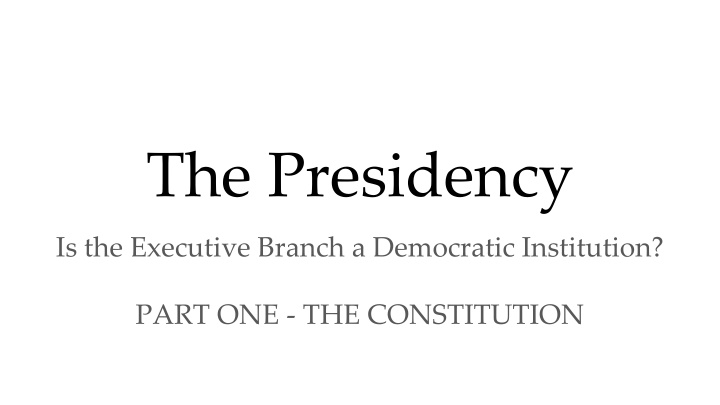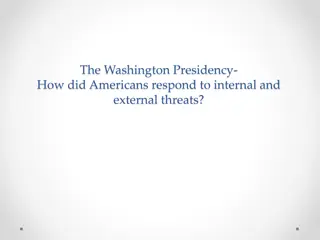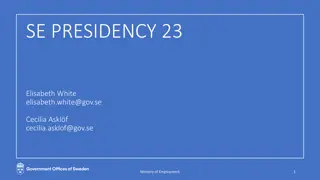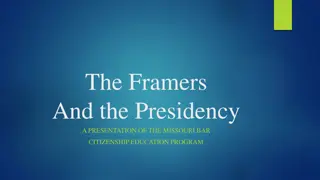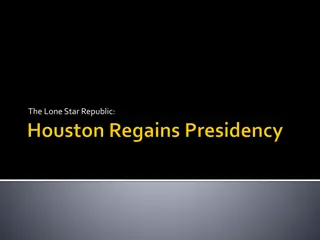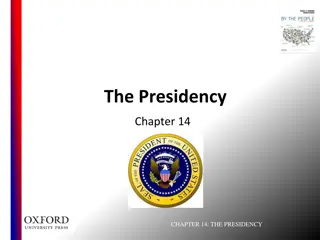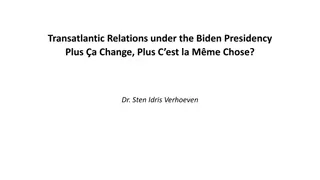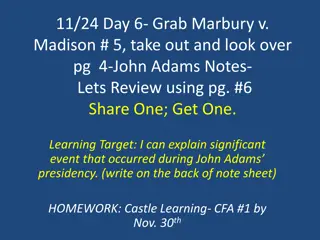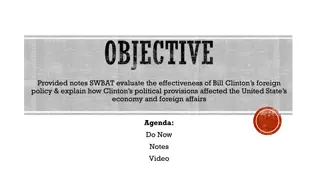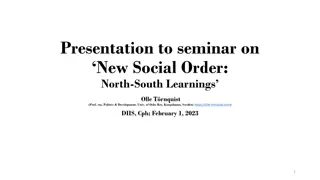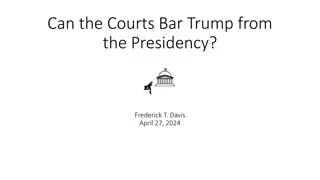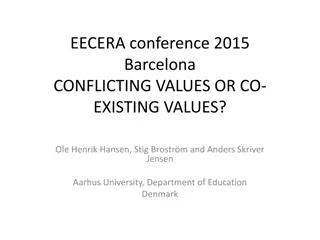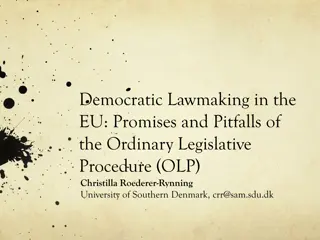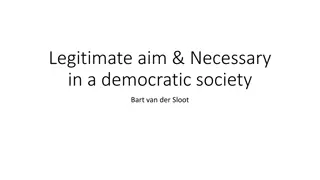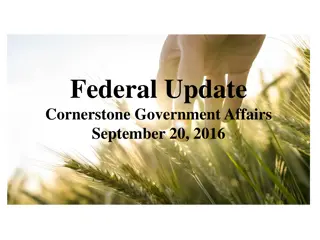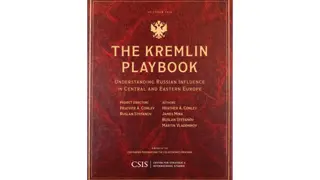The Democratic Presidency
The United States government is rooted in republicanism, not direct democracy as commonly understood today. The balance of presidential power and democratic principles has evolved over time, shaping the institution of the presidency. Explore the constitutional foundations of the Executive Branch and the democratic ideals that influence it.
Download Presentation

Please find below an Image/Link to download the presentation.
The content on the website is provided AS IS for your information and personal use only. It may not be sold, licensed, or shared on other websites without obtaining consent from the author.If you encounter any issues during the download, it is possible that the publisher has removed the file from their server.
You are allowed to download the files provided on this website for personal or commercial use, subject to the condition that they are used lawfully. All files are the property of their respective owners.
The content on the website is provided AS IS for your information and personal use only. It may not be sold, licensed, or shared on other websites without obtaining consent from the author.
E N D
Presentation Transcript
The Presidency Is the Executive Branch a Democratic Institution? PART ONE - THE CONSTITUTION
How Democratic is the Presidency? The United States is generally regarded as having a democratic government using the principles of republicanism. However, the word democracy is not in either the Declaration of Independence or the Constitution, and republican form of government is mentioned only once in the Constitution. The men who wrote the Constitution viewed and defined democracy differently than it is generally understood today. Over the centuries, the process of electing office holders at the federal level has become more direct and more in line with the modern concept of how We the People should be involved in the process of governing. The question of how easily a President can use his power in a monocratic (or even authoritarian) manner is still present and many Presidents, including those most recently in office, have been accused of being tyrants by their critics.
Democracy & the Executive Branch The Executive Branch is outlined in Article II of the Constitution, and Amendments 12, 22, and 25 were added to modify how the President is elected, to set term limits, and to establish a clearer order of succession. When the ratification of the Constitution was being debated, many Anti- Federalists feared a strong executive officer would lead to tyranny. Some Federalists, like Alexander Hamilton, feared the office of President would not be strong enough to provide leadership and order. Read the following parts of the Constitution to assess the balance between the powers and the limits placed on the President and the Executive Branch.
Democracy & the Executive Branch Article II Section 1. The executive power shall be vested in a President of the United States of America. He shall hold his office during the term of four years, and, together with the Vice President, chosen for the same term, be elected, as follows: Each state shall appoint, in such manner as the Legislature thereof may direct, a number of electors, equal to the whole number of Senators and Representatives to which the State may be entitled in the Congress: but no Senator or Representative, or person holding an office of trust or profit under the United States, shall be appointed an elector.
Democracy & the Executive Branch (Amended by the 12thAmendment) The electors shall meet in their respective states, and vote by ballot for two persons, of whom one at least shall not be an inhabitant of the same state with themselves. And they shall make a list of all the persons voted for, and of the number of votes for each; which list they shall sign and certify, and transmit sealed to the seat of the government of the United States, directed to the President of the Senate. The President of the Senate shall, in the presence of the Senate and House of Representatives, open all the certificates, and the votes shall then be counted. The person having the greatest number of votes shall be the President, if such number be a majority of the whole number of electors appointed; and if there be more than one who have such majority, and have an equal number of votes, then the House of Representatives shall immediately choose by ballot one of them for President; and if no person have a majority, then from the five highest on the list the said House shall in like manner choose the President. But in choosing the President, the votes shall be taken by States, the representation from each state having one vote; A quorum for this purpose shall consist of a member or members from two thirds of the states, and a majority of all the states shall be necessary to a choice. In every case, after the choice of the President, the person having the greatest number of votes of the electors shall be the Vice President. But if there should remain two or more who have equal votes, the Senate shall choose from them by ballot the Vice President.
Democracy & the Executive Branch The Congress may determine the time of choosing the electors, and the day on which they shall give their votes; which day shall be the same throughout the United States. No person except a natural born citizen, or a citizen of the United States, at the time of the adoption of this Constitution, shall be eligible to the office of President; neither shall any person be eligible to that office who shall not have attained to the age of thirty five years, and been fourteen Years a resident within the United States. (Amended by the 25thAmendment) In case of the removal of the President from office, or of his death, resignation, or inability to discharge the powers and duties of the said office, the same shall devolve on the Vice President, and the Congress may by law provide for the case of removal, death, resignation or inability, both of the President and Vice President, declaring what officer shall then act as President, and such officer shall act accordingly, until the disability be removed, or a President shall be elected.
Democracy & the Executive Branch The President shall, at stated times, receive for his services, a compensation, which shall neither be increased nor diminished during the period for which he shall have been elected, and he shall not receive within that period any other emolument from the United States, or any of them. Before he enter on the execution of his office, he shall take the following oath or affirmation: "I do solemnly swear (or affirm) that I will faithfully execute the office of President of the United States, and will to the best of my ability, preserve, protect and defend the Constitution of the United States."
Democracy & the Executive Branch Section 2. The President shall be commander in chief of the Army and Navy of the United States, and of the militia of the several states, when called into the actual service of the United States; he may require the opinion, in writing, of the principal officer in each of the executive departments, upon any subject relating to the duties of their respective offices, and he shall have power to grant reprieves and pardons for offenses against the United States, except in cases of impeachment. He shall have power, by and with the advice and consent of the Senate, to make treaties, provided two thirds of the Senators present concur; and he shall nominate, and by and with the advice and consent of the Senate, shall appoint ambassadors, other public ministers and consuls, judges of the Supreme Court, and all other officers of the United States, whose appointments are not herein otherwise provided for, and which shall be established by law: but the Congress may by law vest the appointment of such inferior officers, as they think proper, in the President alone, in the courts of law, or in the heads of departments. The President shall have power to fill up all vacancies that may happen during the recess of the Senate, by granting commissions which shall expire at the end of their next session.
Democracy & the Executive Branch Section 3. He shall from time to time give to the Congress information of the state of the union, and recommend to their consideration such measures as he shall judge necessary and expedient; he may, on extraordinary occasions, convene both Houses, or either of them, and in case of disagreement between them, with respect to the time of adjournment, he may adjourn them to such time as he shall think proper; he shall receive ambassadors and other public ministers; he shall take care that the laws be faithfully executed, and shall commission all the officers of the United States. Section 4. The President, Vice President and all civil officers of the United States, shall be removed from office on impeachment for, and conviction of, treason, bribery, or other high crimes and misdemeanors.
Democracy & the Executive Branch Amendment XII The Electors shall meet in their respective states and vote by ballot for President and Vice-President, one of whom, at least, shall not be an inhabitant of the same state with themselves; they shall name in their ballots the person voted for as President, and in distinct ballots the person voted for as Vice-President, and they shall make distinct lists of all persons voted for as President, and of all persons voted for as Vice- President, and of the number of votes for each, which lists they shall sign and certify, and transmit sealed to the seat of the government of the United States, directed to the President of the Senate;-The President of the Senate shall, in the presence of the Senate and House of Representatives, open all the certificates and the votes shall then be counted;-The person having the greatest Number of votes for President, shall be the President, if such number be a majority of the whole number of Electors appointed; and if no person have such majority, then from the persons having the highest numbers not exceeding three on the list of those voted for as President, the House of Representatives shall choose immediately, by ballot, the President. But in choosing the President, the votes shall be taken by states, the representation from each state having one vote; a quorum for this purpose shall consist of a member or members from two-thirds of the states, and a majority of all the states shall be necessary to a choice. And if the House of Representatives shall not choose a President whenever the right of choice shall devolve upon them, before the fourth day of March next following, then the Vice-President shall act as President, as in the case of the death or other constitutional disability of the President-The person having the greatest number of votes as Vice-President, shall be the Vice-President, if such number be a majority of the whole number of Electors appointed, and if no person have a majority, then from the two highest numbers on the list, the Senate shall choose the Vice-President; a quorum for the purpose shall consist of two-thirds of the whole number of Senators, and a majority of the whole number shall be necessary to a choice. But no person constitutionally ineligible to the office of President shall be eligible to that of Vice-President of the United States.
Democracy & the Executive Branch Amendment XXII Section 1 No person shall be elected to the office of the President more than twice, and no person who has held the office of President, or acted as President, for more than two years of a term to which some other person was elected President shall be elected to the office of the President more than once. But this Article shall not apply to any person holding the office of President, when this Article was proposed by the Congress, and shall not prevent any person who may be holding the office of President, or acting as President, during the term within which this Article becomes operative from holding the office of President or acting as President during the remainder of such term. Section 2 This article shall be inoperative unless it shall have been ratified as an amendment to the Constitution by the legislatures of three-fourths of the several States within seven years from the date of its submission to the States by the Congress.
Democracy & the Executive Branch Amendment XXV Section 1 In case of the removal of the President from office or of his death or resignation, the Vice President shall become President. Section 2 Whenever there is a vacancy in the office of the Vice President, the President shall nominate a Vice President who shall take office upon confirmation by a majority vote of both Houses of Congress. Section 3 Whenever the President transmits to the President pro tempore of the Senate and the Speaker of the House of Representatives his written declaration that he is unable to discharge the powers and duties of his office, and until he transmits to them a written declaration to the contrary, such powers and duties shall be discharged by the Vice President as Acting President.
Democracy & the Executive Branch Section 4 Whenever the Vice President and a majority of either the principal officers of the executive departments or of such other body as Congress may by law provide, transmit to the President pro tempore of the Senate and the Speaker of the House of Representatives their written declaration that the President is unable to discharge the powers and duties of his office, the Vice President shall immediately assume the powers and duties of the office as Acting President. Thereafter, when the President transmits to the President pro tempore of the Senate and the Speaker of the House of Representatives his written declaration that no inability exists, he shall resume the powers and duties of his office unless the Vice President and a majority of either the principal officers of the executive department or of such other body as Congress may by law provide, transmit within four days to the President pro tempore of the Senate and the Speaker of the House of Representatives their written declaration that the President is unable to discharge the powers and duties of his office. Thereupon Congress shall decide the issue, assembling within forty-eight hours for that purpose if not in session. If the Congress, within twenty-one days after receipt of the latter written declaration, or, if Congress is not in session, within twenty-one days after Congress is required to assemble, determines by two-thirds vote of both Houses that the President is unable to discharge the powers and duties of his office, the Vice President shall continue to discharge the same as Acting President; otherwise, the President shall resume the powers and duties of his office.
Democracy & the Executive Branch EVALUATE & DISCUSS 1. What is Executive Power ? Why do you think the Framers of the Constitution were not more specific in defining it? 2. Identify (highlight, circle, underline, etc.) all the powers and duties of the Executive Branch that could POTENTIALLY be abused in a monocratic (non-democratic) manner. 3. Identify (highlight, circle, underline, etc. in a different way) all the limits and checks on the Executive Branch that could be used to stop or limit Executive actions. 4. What is an Elector ? Is the Electoral College a democratic institution? 5. How does the 12thAmendment change the process of electing the President? Does the 12thAmendment make the process more or less democratic ?
Democracy & the Executive Branch EVALUATE & DISCUSS 6. Why is the 12thAmendment so much longer and more detailed than the previous 11 Amendments? 7. Does requiring the President to be a Natural Born Citizen impact how democratic the office is? 8. Is it significant that the Constitution uses the term Person when describing who is eligible to be President, rather than some other term? 9. Is the existence of a system of impeachment and removal enough of a check on tyranny and other abuses of power? 10. Does having a formal two term or ten-year limit on serving as President make the position more democratic ?
Democracy & the Executive Branch 1. Was the method for electing the President intended to be a democratic process, based on the understanding of democracy in the 18th Century? 1. Is the original method for electing the President democratic under a modern understanding of democracy? 1. Was the Presidency designed to be subservient to the Legislative Branch?
